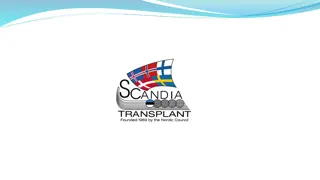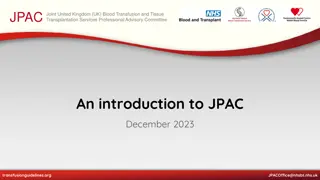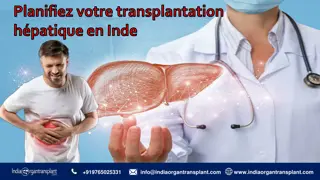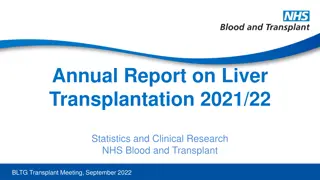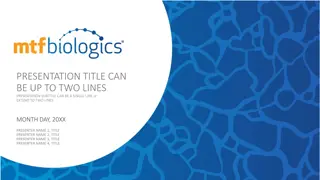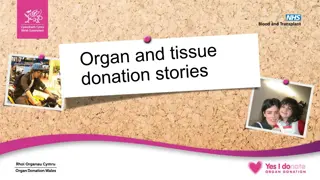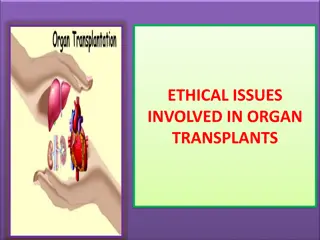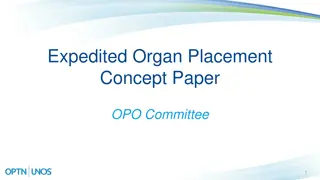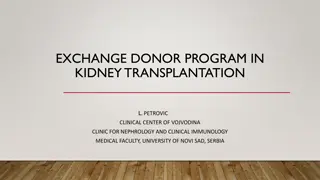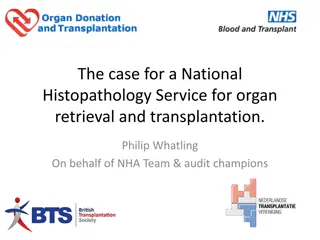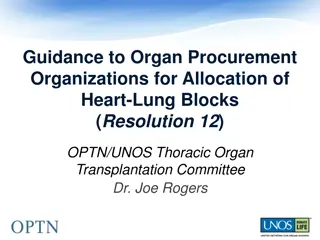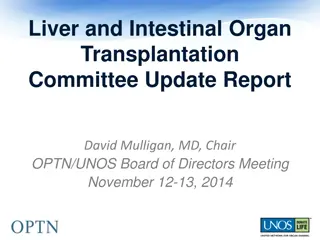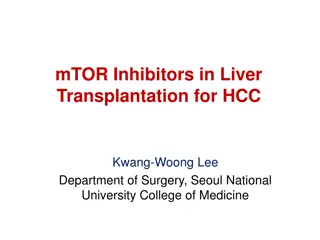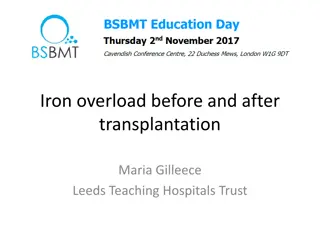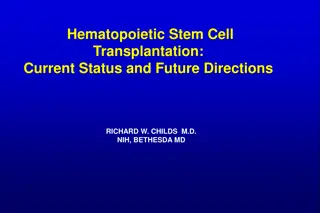Organ Transplantation: Key Concepts and Challenges
Organ transplantation is a critical treatment for end-stage organ failure, involving immunological barriers and medical considerations. Learn about allograft rejection, immunosuppressive therapy, organ donation issues, transplant outcomes, and the challenges of chronic graft rejection and organ shortages. Definitions of terms like allograft and xenograft are also provided.
Download Presentation

Please find below an Image/Link to download the presentation.
The content on the website is provided AS IS for your information and personal use only. It may not be sold, licensed, or shared on other websites without obtaining consent from the author.If you encounter any issues during the download, it is possible that the publisher has removed the file from their server.
You are allowed to download the files provided on this website for personal or commercial use, subject to the condition that they are used lawfully. All files are the property of their respective owners.
The content on the website is provided AS IS for your information and personal use only. It may not be sold, licensed, or shared on other websites without obtaining consent from the author.
E N D
Presentation Transcript
Organ Transplantation Organ Transplantation NASERALLA G ELSAADI CONSULTANT GENERAL SURGEON CLINICAL SURGERY-IN-GENERAL DEPARTMENT OF SURGERY BENGHAZI MEDICAL CENTRE
3 Learning objectives Learning objectives To appreciate the immunological basis of allograft rejection To know the principles of immunosuppressive therapy To be aware of the side effects of non-specific immunosuppression To be familiar with the major issues concerning organ donation To appreciate the main indications for organ transplantation To be able to give an account of the causes of graft dysfunction To know the likely outcomes after transplantation
4 Introduction Introduction Organ transplantation is the gold standard treatment for many patients with end-stage organ failure. There are surgical and medical barriers to successful organ transplantation; however, the major biological hurdle is immunological. This immunological barrier is present when matching donors to recipients, and is also fundamental to subsequent graft survival as an immune response may lead to rejection and graft destruction.
5 Introduction Introduction In addition, the immunosuppressive medications needed to prevent organ rejection have significant clinical implications to the recipient. Therefore, an understanding of transplant immunology is essential for all clinicians involved in organ transplantation.
6 "The two major problems in organ transplantation are: "The two major problems in organ transplantation are: 1 1- - Chronic graft rejection and the side effects of non-specific immunosuppression; 2 2- - The shortage of organs for transplantation."
Definitions Definitions 7 Allograft Allograft: an organ or tissue transplanted from one individual to another Alloantigen Alloantigen: transplant antigen Alloantibody Alloantibody: transplant antibodies HLA HLA: human leukocyte antigen, the main trigger to graft rejection Xenograft Xenograft: a graft performed between different species Orthotopic Orthotopic graft graft: a graft placed in its normal anatomical site Heterotopic Heterotopic graft graft: a graft placed in a site different from that where the organ is normally located
8 Immunology of graft rejection Immunology of graft rejection The immune system is a highly complex biological system whose function is to differentiate self from non-self, and subsequently eliminate substances recognized as foreign. It is characterized by its complexity, multiplicity of effector mechanisms, and (in higher organisms) its immunological memory. Although these processes have evolved primarily to detect and destroy microorganisms (and cancer), the same mechanisms result in the rejection of foreign tissue or transplants.
9 There are essentially three types of tissue antigens There are essentially three types of tissue antigens that can be recognized by the immune system and subsequently provoke an alloimmune response: ABO blood group antigens, HLA antigens, Non- HLA antigens (minor histocompatibility antigens).
10 ABO blood group antigens ABO blood group antigens ABO blood group antigens are glycoproteins present on the cell membranes of red blood cells, and a wide variety of tissues including endothelium. There are four major ABO phenotypes: A, B, O and AB. In addition to surface antigens, individuals develop antibodies against the A and/or B antigens that are not present on the individual s tissue. For example, blood group A individuals will have anti-B antibodies circulating in the blood. These antibodies appear in the blood soon after birth following exposure to antigens of similar structure to A and B antigens (molecular mimicry).
12 HLA antigens HLA antigens In contrast, HLA antigens are a significant hurdle to clinical organ transplantation as they are a major target for the immune response. HLA antigens are cell surface proteins whose biological function is to present small portions of proteins (peptides) for recognition by receptors of cells of the immune system. Genes that encode for HLA antigens are found in the major histocompatibility complex (MHC), a genetic region located on the short arm of chromosome 6 in humans. MHC and HLA are terms that are often used interchangeably, though strictly MHC refers to the area of the genome, and HLA refers to the human protein structure.
14 Minor histocompatibility antigens Minor histocompatibility antigens Non-HLA antigens may also be able to act as transplant tissue antigens. These non-HLA proteins show some degree of polymorphism between individuals. As a consequence, peptides derived from these non-HLA antigens on allogeneic grafts can be presented on HLA class I or II molecules and recognized by the recipient s immune system. The clinical significance of these non-HLA antigens is thought to be minimal in solid organ transplantation, thus explaining why they are also known as minor histocompatibility antigens.
Antigen recognition Antigen recognition 15 In order for the recipient s immune system to respond to foreign (non-self) antigens and reject the tissues on which they are expressed, the immune system must be able to recognize these antigens. Recipient CD Recipient CD4 4 T cells (T helper cells) T cells (T helper cells) play a central role in activating and maintaining the alloimmune response. Recognition of foreign HLA molecules by recipient CD4 T cells occurs in host lymphoid tissue through two main pathways: the indirect and direct pathways of allorecognition.
18 Effector pathways Effector pathways There are three main effector pathways in the adaptive There are three main effector pathways in the adaptive alloimmune response: alloimmune response: cellular cytotoxicity, the humoural response, and the delayed type hypersensitivity (DTH) reaction. All three arms are initially dependent on cytokines secreted by CD4 T helper cells. Factors Factors such as the degree of activation of the innate immune system, antigen dose, and previous immune stimuli determine which patterns of cytokines are produced by T helper cells and therefore the effector mechanism that predominates.
21 Tolerance in transplantation Tolerance in transplantation In the transplant setting, tolerance can be defined as "the absence of a damaging alloantigen-specific immune response without the need for ongoing exogenous immunosuppression and with an intact response to other antigens". Tolerance has been described as the holy grail of transplantation, as it would prevent allograft rejection and do away with the need for immunosuppression and its associated toxicity.
Types of rejection Types of rejection 22 Rejection is "an immune-mediated destruction of transplanted tissue". Rejection can be classified by time-course (hyperacute, acute, or chronic rejection) or underlying mechanism (cell-mediated, antibody-mediated). With early detection, treatment with increased immunosuppression is usually successful. Treatment depends on the type of rejection, its underlying cause, and severity.
24 Causes of allograft dysfunction Causes of allograft dysfunction Early Early Primary non-function (irreversible ischaemic damage) Delayed function (reversible ischaemic injury) Hyperacute and acute rejection Arterial or venous thrombosis of the graft vessels Drug toxicity (e.g. calcineurin inhibitor toxicity) Infection (e.g. cytomegalovirus disease in graft)
25 Causes of allograft dysfunction Causes of allograft dysfunction Late Late Chronic rejection Arterial stenosis Recurrence of original disease in graft (glomerulonephritis, hepatitis C) Mechanical obstruction (ureter, common bile duct)
Immunosuppressive therapy Immunosuppressive therapy 26 Immunosuppressive drugs Immunosuppressive drugs are used to prevent an alloimmune response or reverse it if it becomes established. Their mechanisms of action vary by class, but are aimed primarily at preventing lymphocyte activation, proliferation, or downstream effector mechanisms. Unfortunately Unfortunately, all modern immunosuppressants act non-specifically, i.e. they suppress the immune response not only to the transplanted organ, but also to infectious agents and neoplastic cells.
Side effects of non Side effects of non- -specific immunosuppression specific immunosuppression 27 Infection Infection Transplant recipients are at high risk of opportunistic infection, especially by viruses Bacterial and fungal infections are also common Risk of infection is greatest during the first 6 months Chemoprophylaxis is important for high-risk patients Viral infection may result from reactivation of latent virus or from primary infection Cytomegalovirus is a major problem Pre-transplant vaccination against community-acquired infection should be considered.
28 Side effects of non Side effects of non- -specific immunosuppression specific immunosuppression Malignancy Malignancy Most types of cancer are more common after transplantation (approximately two-fold incidence); Recipients, especially children, are at risk of post-transplant lymphoproliferative disease; There is a very high risk of squamous cell cancer of the skin and recipients should have a regular skin review.
30 Principles of immunosuppression Principles of immunosuppression Aim is to maximise graft protection with minimum of side effects; Most regimens are based on calcineurin blockade and include steroids and an anti-proliferative agent; Need for immunosuppression is highest in the first 3 months but indefinite treatment is needed; Immunosuppression increases the risk of infection and malignancy.
31 Antibody Antibody- -incompatible transplantation incompatible transplantation Antibody-incompatible transplantation (AIT) (i.e. transplantation in the known presence of significant levels of anti-donor ABO and/ or HLA antibodies) is a rapidly evolving field that has allowed for expansion of the donor pool.
32 Antibody Antibody- -incompatible transplantation incompatible transplantation ABO and HLA incompatible transplantation is currently only widely applicable to living donor transplantation as organ recipients need planned intense pre-transplant treatment over a number of weeks to reduce antibody levels to acceptable levels at the time of surgery. This avoids hyperacute or accelerated acute antibody-mediated rejection. At present AIT is used most commonly in live donor kidney transplantation, though in some countries (e.g. Japan) it has expanded to include live donor liver transplantation.
33 Outcome after transplantation Outcome after transplantation Transplantation improves the quality and duration of life in most recipients; Transplant outcome has improved progressively over the last two decades and continues to improve; Improved outcome is due to better immunosuppression, organ preservation, chemoprophylaxis and technical advances Graft survival after kidney, liver and heart transplantation is >90% at 1 year and >80% at 5 years
34 Outcome after transplantation Outcome after transplantation Chronic rejection is the most common cause of graft failure after all types of solid-organ transplant; Recurrence of the original disease necessitating transplantation may also lead to graft failure; Death with a functioning transplant from cardiovascular disease/event is relatively common
35 Factors determining organ function Factors determining organ function after transplantation after transplantation Donor characteristics Donor characteristics Extremes of age Presence of pre-existing damage in transplanted organ Haemodynamic and metabolic instability Procurement Procurement- -related factors Warm ischaemic time Type of preservation solution Cold ischaemic time related factors
36 Factors determining organ function Factors determining organ function after transplantation after transplantation Recipient Recipient- -related factors related factors Technical factors relating to implantation Haemodynamic and metabolic stability Immunological factors Presence of drugs that impair transplant function
37 Conclusions Conclusions The human immune system evolved to identify and destroy microbial invaders and cancerous cells. In addition, its ability to distinguish self from non-self makes it a formidable barrier to organ transplantation. Knowledge of the antigen systems that provoke an immune response is essential in order to understand how recipients are selected for donor organs, and the functioning of the immunosuppressive medications required to prevent allograft rejection.
38 Conclusions Conclusions Although these drugs act non-specifically, and are associated with significant side-effects, their use has enabled successful organ transplantation. Despite the achievements of modern immunosuppression, late graft loss from chronic alloimmune responses is a major cause of graft failure and recipient death. The development of reliable allospecific transplant tolerance is close to becoming a clinical reality, but remains tantalizingly out of reach.
39 THANKS A LOT FOR YOUR ATTENTION THANKS A LOT FOR YOUR ATTENTION



